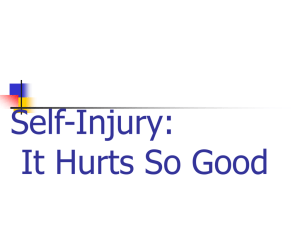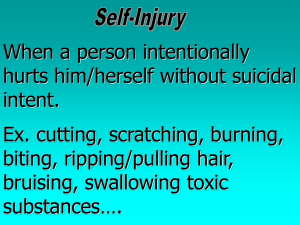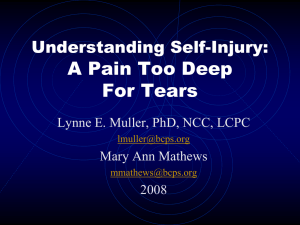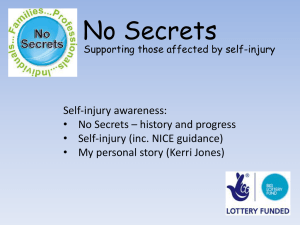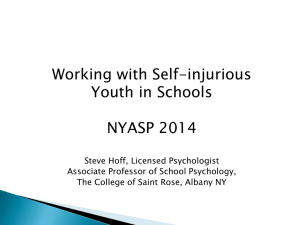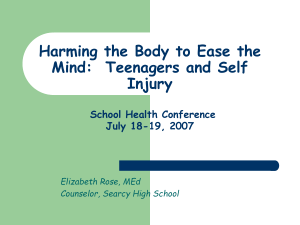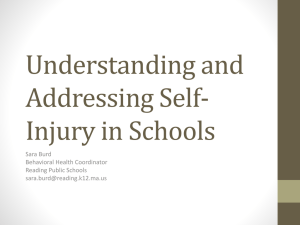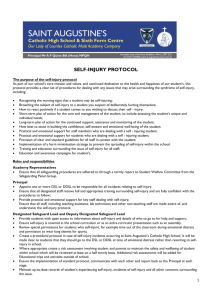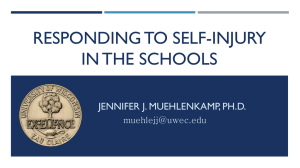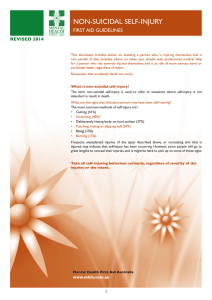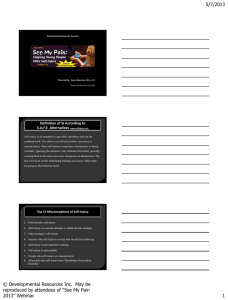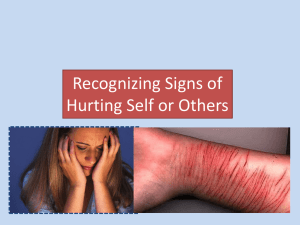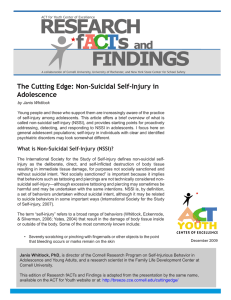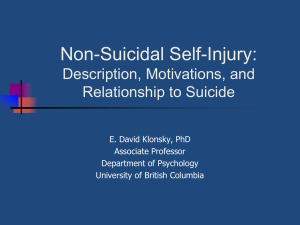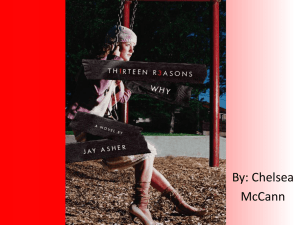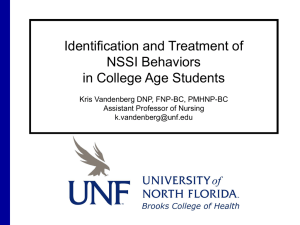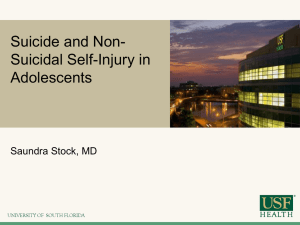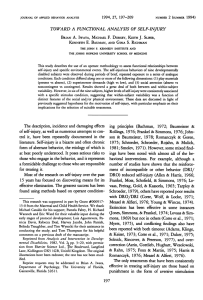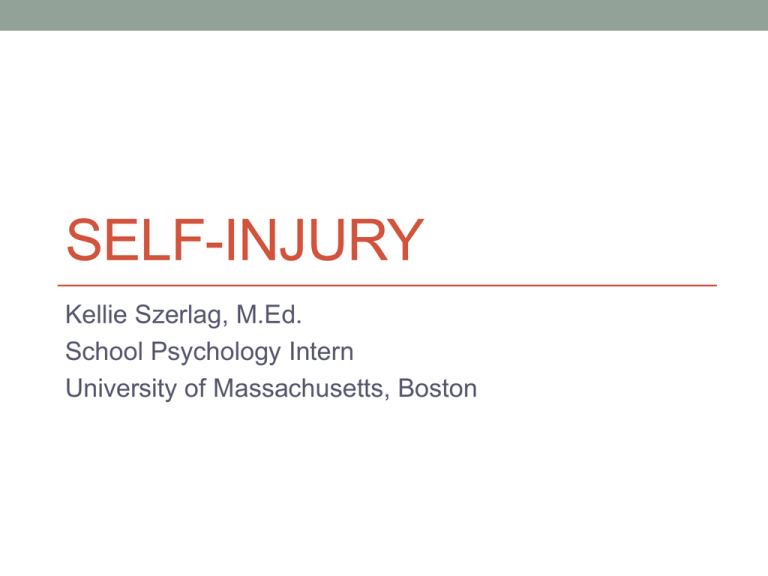
SELF-INJURY
Kellie Szerlag, M.Ed.
School Psychology Intern
University of Massachusetts, Boston
What’s Happening: Adolescence
• Time of transition and change.
• Maturing bodies and minds
• Combination of Thoughts/Feelings: center of attention,
but alone in experiences.
• Early Adolescence: world is more black and white.
• Later Adolescence: better able to understand self.
• Learning How to:
• Establish and maintain relationships.
• Define self and purpose.
• Understand themselves and the world.
Why discuss Self-Injury?
• Nonsuicidal self-injury (NSSI): is a growing
public health concern among adolescents.
• Self-injury is often identified in schools
What is Self-Injury?
• Terms: self-harm, cutting, self-mutilation, & non-
suicidal self-injury (NSSI)
• NSSI: “the deliberate destruction of one’s own
body tissue without the intent of death” (Taylor,
Peterson, & Fischer, 2012).
Self-Injury vs. Suicide Attempts
• Self-injurers are typically not attempting
suicide.
• Connection to thoughts of suicide later in
life.
• Physically harmful and dangerous
• Related to impulsiveness
• Dysfunctional/Maladaptive coping strategy
Most Common Forms of Self-Injury
• Skin cutting
• Burning
People who Self-Injure might:
• Pick or interfere with wound healing
• Engage in behavior secretively
• Bathrooms or other secluded areas.
Identifying Self-injury
• Frequent unexplained scars/burns
• Non-dominant arms, forearms, hands
• Can be anywhere on body
• “Covering-up” with clothing
• Constant wearing of wrist bands, long sleeves,
multiple bracelets
Who is at-risk?
• Victims of abuse
• Family Conflict
• Mental illness
• Higher rates among:
• Females
• LGBTQ
Who is at Risk?
• Impulsivity
• Low self esteem
• Low levels of resiliency
• Poor problem-solving skills
• Difficulty regulating emotions
• Often related drug and alcohol abuse
Adolescents who self-injure reported they
do it to:
• Self-soothe
• Reduce severe distress
• “Feel good”
• Express negative feelings
• Hopelessness, worthlessness, depression,
anxiety or distress
• Fight feelings of numbness
• Feel a sense of control
Why Adolescents Self-Injure
• Belief: self-injury achieves emotional
equilibrium when they can’t regulate or
control emotions (self-soothe).
• To relieve intolerable emotional pain
• To communicate a deep sense of anguish.
• A cry for help
Self-Injury in Social Groups
• Sometimes considered “contagious” among
groups of friends.
• Importance of protocols for dealing with self-
injury in schools.
• Parent involvement and communication with
children.
Protective Factors
• Connectedness
• Access to mental health services
• Spiritual life
• Stable families
Roles of the School
• Communication is important between school-
home-outside clinician.
• Support Staff and Medical Professionals
• School should be involved in the reinforcement of
coping strategies and communication skills.
Responding to Self-Injury
• Medical attention
• Outside counseling or therapy
• Have a strong support system, treatment can be
long and tough for parents.
• Support siblings
Responding to Self-Injury
• Understand self-injury as a way to cope or handle
intense feelings.
• Encourage them to share feelings through
journaling or in art (drawing, painting, creating).
• Remove tools
• After-school activities or hobby/interest.
• Community outreach
Things to Avoid
• Avoid statements that might cause guilt or shame
• Try not to appear shocked by this behavior.
• Avoid talking about their self-injury in front of
friends or with other relatives.
• Try to teach them what you think they should do
• Avoid punishment for self-injurious behaviors.
• Overprotecting might be harmful, but try to be
aware of what’s going on.
• Don’t blame yourself for your child’s behavior.
Communication and Bonds as Protective
Factors
• Family connectedness is a protective factor.
• Reduced likelihood of harmful or dangerous behaviors (e.g., drugs,
alcohol, or sex, etc.)
• Fewer mental health problems
• Increased likelihood of making “right” choices and standing up for
believes.
• Predicts more constructive coping skills and social skills
• Difficult topics are better discussed when connectedness
and communication are in place.
But my child pulls away…
• Searching for own identity.
• Time spent with family drops an estimated 21%
• More times with friends, work, or dating relationships.
• Does not mean there is not a secure bond or good
relationship
• Conflicts happen
• Not a sign of poor relationship
• Important that parents and adolescent maintain
understanding and empathy while disagreeing
• Confidently state opinion show
empathy/understanding of other point of view.
Communicating with your Child
• Ask open questions (what or how) to encourage
him/her to open up.
• Allow conversations to revolve around what
interests your child.
• Spend time together, with their choice of activity.
• Dinner time and Cooking together
• Connections with other family members
Safety
• Independence but still developing good decision making
skills.
• Peer approval is important.
• Discuss Safety and dangerous consequences of:
• Motor vehicles
• Substance abuse
• Protective Gear in sports
• Healthy Relationships
• Internet Safety
What helps your family stay connected?
Approaches to discussing difficult or sensitive
topics that have worked for your families?
Local Resources & Support Lines
• Wayside Youth & Family Support (508)-879•
•
•
•
9800http://www.waysideyouth.org/
Advocates, Inc (508)-628-6300
www.adocatesinc.org
National Suicide Prevention Lifeline
1-800-273-TALK (8255)
Samaritans Statewide Befriending Line
1-877-870-HOPE (4673) (24 hrs)
Samariteens Helpline
1-800-525-TEEN (8336)
3pm-9pm weekdays/9am-9pm weekends
Additional Resources
American Self Harm Information Clearinghouse
• http://selfinjury.org
National Mental Health Association (fact sheet)
• www.nmha.org/infoctr/factsheets/selfinjury.cfm
National Association of School Psychology (NASP)
• http://www.nasponline.org/families/index.aspx
• Questions?
Thank you!
References
Bakken, N. W., & Gunter, W. D. (2012). Self-cutting and suicidal ideation among
adolescents: Gender differences in the causes and correlates of selfinjury. Deviant Behavior, 33(5), 339-356. doi:10.1080/01639625.2011.584054
Brock, S. E. (2002). Crisis Theory: A Foundation for the Comprehensive School
Crisis Response Team. In S.E. Brock, P.J. Lazarus, % S.R. Jimerson (eds.),
Best Practices in School Crisis Prevention and Intervention (pp. 5-17).
Bethesda, MD: National Association of School Psychologists.
Brock, S. E., Nickerson, A. B., Reeves, M. A., Jimerson, S. R., Lieberman, R. A., &
Feinberg, T. A. (2009). School Crisis Prevention and Intervention: The
PREPaRE Model. Bethseda: National Association of School Psychologists.
Bubrick, K., Goodman, J. & Whitlock, J. (2010). Non-suicidal self-injury in schools:
Developing and implementing school protocol. [Fact sheet] Cornell Research
Program on Self-Injurious Behavior in Adolescents and Young Adults.
Retrieved from http://crpsib.com/userfiles/NSSI-schools.pdf
Cromer B. Adolescent Development. In: Kliegman RM, Behrman RE, Jenson HB, Stanton BF,
eds. Nelson Textbook of Pediatrics. 19th ed. Philadelphia, Pa: Saunders Elsevier; 2011:
chap 104
Gonzales, A., & Bergstrom, L. (2013). Adolescent non‐suicidal self‐injury (NSSI)
interventions. Journal Of Child And Adolescent Psychiatric Nursing, 26(2), 124-130.
Guan, K., Fox, K. R., & Prinstein, M. J. (2012). Nonsuicidal self-injury as a time-invariant
predictor of adolescent suicide ideation and attempts in a diverse community
sample. Journal Of Consulting And Clinical Psychology, 80(5), 842-849.
doi:10.1037/a0029429
Klonsky, E., May, A. M., & Glenn, C. R. (2013). The relationship between nonsuicidal self-injury
and attempted suicide: Converging evidence from four samples. Journal Of Abnormal
Psychology, 122(1), 231-237. doi:10.1037/a0030278
Lieberman, R. (2004) Understanding and Responding to Students Who Self-Mutilate. Principal
Leadership Magazine, Vol. 4, No. 7, March 2004, Produced in cooperation with the
National Association of School Psychologists.
Muehlenkamp, J., Brausch, A., Quigley, K., & Whitlock, J. (2013). Interpersonal
features and functions of nonsuicidal self-injury. Suicide And Life-Threatening
Behavior, 43(1), 67-80. doi:10.1111/j.1943-278X.2012.00128.x
Radovic, S., & Hasking, P. (2013). The relationship between portrayals of
nonsuicidal self-injury, attitudes, knowledge, and behavior. Crisis: The Journal
Of Crisis Intervention And Suicide Prevention,34(5), 324-334.
doi:10.1027/0227-5910/a000199
Self-harm in young adults. National Alliance on Mental Illness.
http://www.nami.org/Content/ContentGroups/Helpline1/SelfInjury_Fact_Sheet_
FINAL.pdf. Accessed Oct. 11, 2010.
Sornberger, M. J., Smith, N., Toste, J. R., & Heath, N. L. (2013). Nonsuicidal
self‐injury, coping strategies, and sexual orientation. Journal Of Clinical
Psychology, 69(6), 571-583. doi:10.1002/jclp.21947
Walsh, B. (2012). Treating Self-Injury: A Practical Guide (2 ed.). New York, New
York: Guilford Publications.

